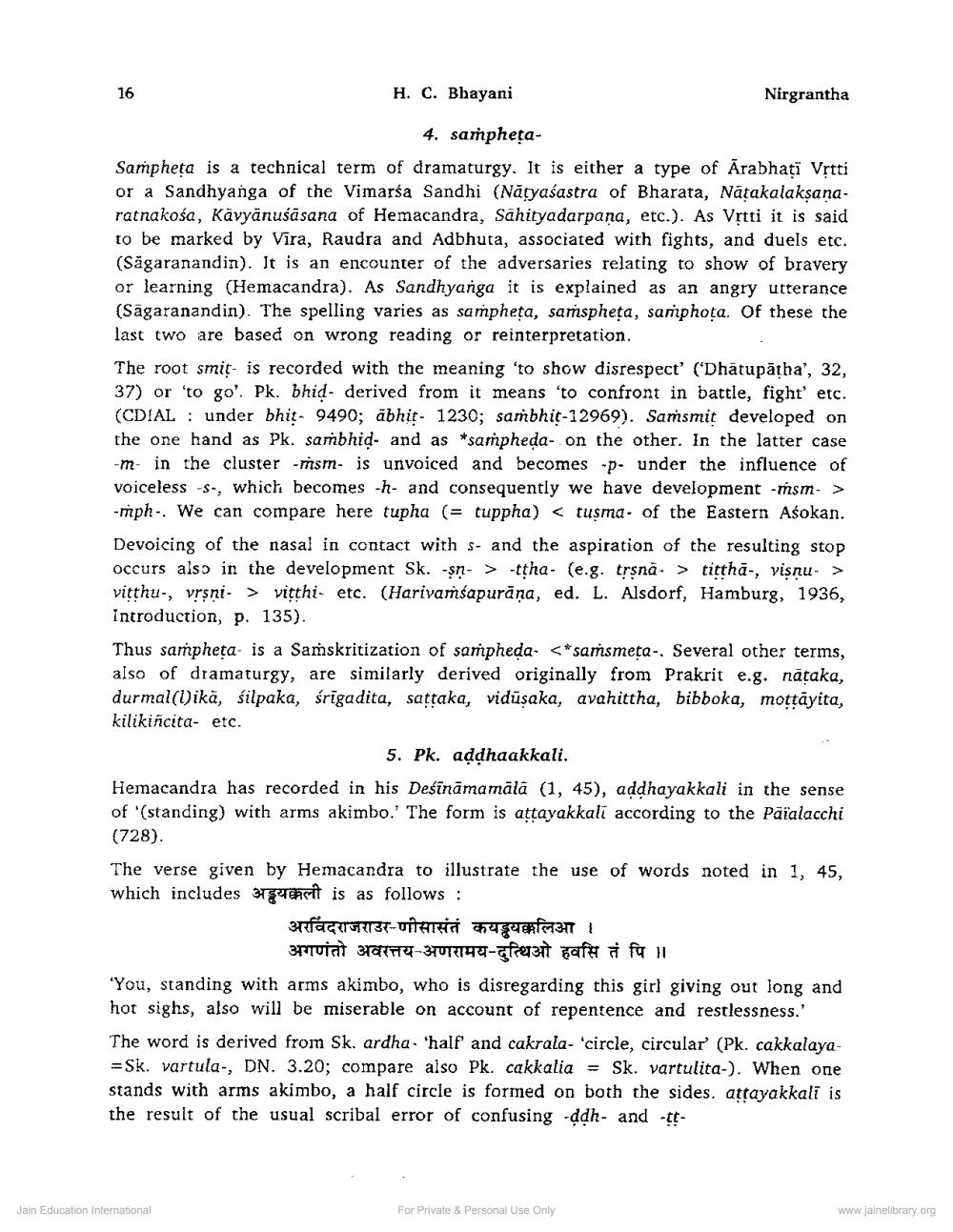Book Title: Etymological Notes Author(s): H C Bhayani Publisher: Z_Nirgrantha_1_022701.pdf and Nirgrantha_2_022702.pdf and Nirgrantha_3_022703.pdf View full book textPage 3
________________ 16 H. C. Bhayani Nirgrantha 4. samphetaSampheta is a technical term of dramaturgy. It is either a type of Arabhati Vrtti or a Sandhyanga of the Vimarśa Sandhi (Nătyaśastra of Bharata, Nátakalaksanaratnakośa, Kävyänuśāsana of Hemacandra, Sahityadarpana, etc.). As Vịtti it is said to be marked by Vīra, Raudra and Adbhuta, associated with fights, and duels etc. (Sågaranandin). It is an encounter of the adversaries relating to show of bravery or learning (Hemacandra). As Sandhyanga it is explained as an angry utterance (Sāgaranandin). The spelling varies as sampheta, samspheta, samphota. Of these the last two are based on wrong reading or reinterpretation. The root smit is recorded with the meaning to show disrespect' (“Dhätupātha', 32, 37) or 'to go'. Pk. bhid- derived from it means 'to confront in battle, fight' etc. (CDIAL : under bhit- 9490; ābhit- 1230; sambhit-12969). Samsmit developed on the one hand as Pk. sambhid- and as *sampheda- on the other. In the latter case -m- in the cluster -msm- is unvoiced and becomes up. under the influence of voiceless -s-, which becomes -h- and consequently we have development -msm-> -mph-. We can compare here tupha (= tuppha) < tusma. of the Eastern Asokan. Devoicing of the nasal in contact with s- and the aspiration of the resulting stop occurs also in the development Sk. -sn- > -ttha- (e.g. trsna. > titthā, visnu-> vitthu-, vrsni. > vitthi. etc. (Harivamśapurāņa, ed. L. Alsdorf, Hamburg, 1936, Introduction, p. 135). Thus sampheta- is a Samskritization of sampheda. <*samsmeta-. Several other terms, also of dramaturgy, are similarly derived originally from Prakrit e.g. nataka, durmal(Wikā, śilpaka, śrigadita, sattaka, vidūsaka, avahittha, bibboka, mottāyita, kilikincita- etc. 5. Pk. addhaakkali. Hemacandra has recorded in his Deśīnāmamālā (1, 45), addhayakkali in the sense of '(standing) with arms akimbo.' The form is attayakkali according to the Paialacchi (728). The verse given by Hemacandra to illustrate the use of words noted in 1, 45, which includes 3 tearft is as follows : अरविंदराजराउर-णीसासंतं कयड्वयकलिआ । अगणंतो अवरत्तय-अणरामय-दुत्थिओ हवसि तं पि । 'You, standing with arms akimbo, who is disregarding this girl giving out long and hot sighs, also will be miserable on account of repentence and restlessness.' The word is derived from Sk. ardha. 'half and cakrala- 'circle, circular (Pk. cakkalaya=Sk. vartula-, DN. 3.20; compare also Pk. cakkalia = Sk. vartulita-). When one stands with arms akimbo, a half circle is formed on both the sides, attayakkali is the result of the usual scribal error of confusing ddh- and -tt Jain Education International For Private & Personal Use Only www.jainelibrary.orgPage Navigation
1 2 3 4 5 6 7 8
